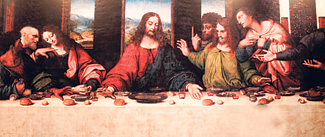PARIS (AFP) - How would the Last Supper look if it were painted according to today's appetites?
Would it be a simple, frugal meal, or cosmopolitan and supersized, in the spirit of our times?
That intriguing question is addressed by a pair of US academics who analysed 52 of the most famous paintings of the Last Supper painted between 1000 and 2000.
 |
| The main dishes depicted in the paintings contained fish or eel (18 percent), lamb (14 percent) and pork (seven percent). The remaining paintings had no discernable main dish. |
Over a thousand years, the portions of food placed before Jesus and his disciples grew astonishingly, they found. Using computer-aided design technology, the pair scanned the main dish, bread and plates and calculated the size of portion relative to the size of the average head in the painting.
Over a thousand years, the size of the main dish progressively grew by 69.2 per cent, plate size by 65.6 percent and bread size by 23.1 percent, they found.
The growing size reflects the success of agriculture over the past 10 centuries, say the researchers.
"The last thousand years have witnessed dramatic increases in the production, availability, safety, abundance and affordability of food," said Brian Wansink, a professor of marketing and applied economics at Cornell University, New York. "We think that as art imitates life, these changes have been reflected in paintings of history's most famous dinner." The study was published in Britain's International Journal of Obesity.
According to the New Testament, the Last Supper took place on an evening of the Jewish festival of Passover, the day before Christ's betrayal and subsequent crucifixion, although it makes no mention of what was eaten. |


